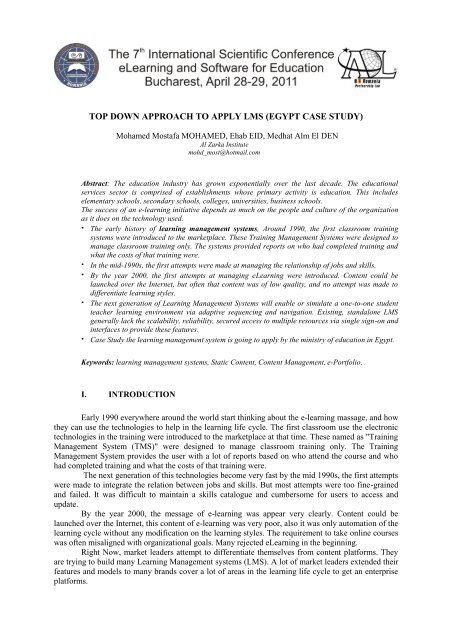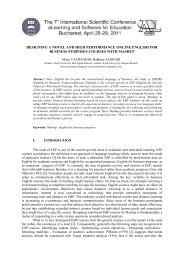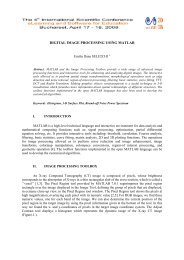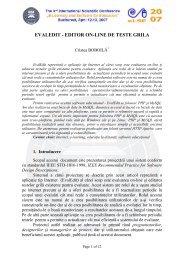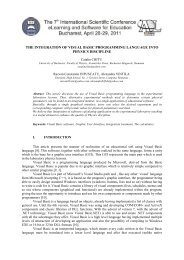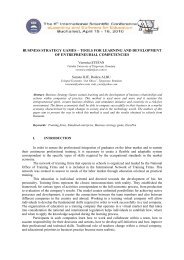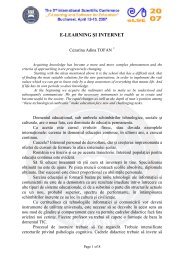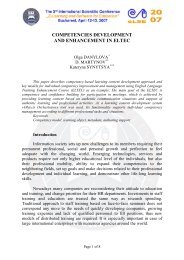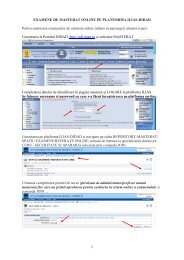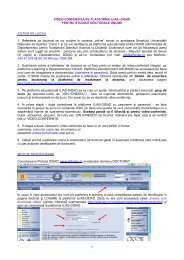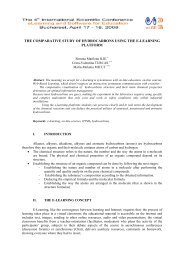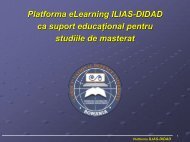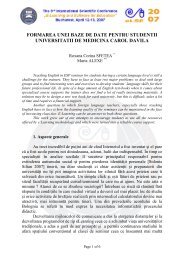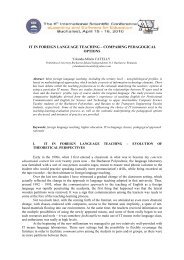top down approach to apply lms (egypt case study)
top down approach to apply lms (egypt case study)
top down approach to apply lms (egypt case study)
Create successful ePaper yourself
Turn your PDF publications into a flip-book with our unique Google optimized e-Paper software.
TOP DOWN APPROACH TO APPLY LMS (EGYPT CASE STUDY)<br />
Mohamed Mostafa MOHAMED, Ehab EID, Medhat Alm El DEN<br />
Al Zarka Institute<br />
mohd_most@hotmail.com<br />
Abstract: The education industry has grown exponentially over the last decade. The educational<br />
services sec<strong>to</strong>r is comprised of establishments whose primary activity is education. This includes<br />
elementary schools, secondary schools, colleges, universities, business schools.<br />
The success of an e-learning initiative depends as much on the people and culture of the organization<br />
as it does on the technology used.<br />
· The early his<strong>to</strong>ry of learning management systems, Around 1990, the first classroom training<br />
systems were introduced <strong>to</strong> the marketplace. These Training Management Systems were designed <strong>to</strong><br />
manage classroom training only. The systems provided reports on who had completed training and<br />
what the costs of that training were.<br />
· In the mid-1990s, the first attempts were made at managing the relationship of jobs and skills.<br />
· By the year 2000, the first attempts at managing eLearning were introduced. Content could be<br />
launched over the Internet, but often that content was of low quality, and no attempt was made <strong>to</strong><br />
differentiate learning styles.<br />
· The next generation of Learning Management Systems will enable or simulate a one-<strong>to</strong>-one student<br />
teacher learning environment via adaptive sequencing and navigation. Existing, standalone LMS<br />
generally lack the scalability, reliability, secured access <strong>to</strong> multiple resources via single sign-on and<br />
interfaces <strong>to</strong> provide these features.<br />
· Case Study the learning management system is going <strong>to</strong> <strong>apply</strong> by the ministry of education in Egypt.<br />
Keywords: learning management systems, Static Content, Content Management, e-Portfolio.<br />
I. INTRODUCTION<br />
Early 1990 everywhere around the world start thinking about the e-learning massage, and how<br />
they can use the technologies <strong>to</strong> help in the learning life cycle. The first classroom use the electronic<br />
technologies in the training were introduced <strong>to</strong> the marketplace at that time. These named as "Training<br />
Management System (TMS)" were designed <strong>to</strong> manage classroom training only. The Training<br />
Management System provides the user with a lot of reports based on who attend the course and who<br />
had completed training and what the costs of that training were.<br />
The next generation of this technologies become very fast by the mid 1990s, the first attempts<br />
were made <strong>to</strong> integrate the relation between jobs and skills. But most attempts were <strong>to</strong>o fine-grained<br />
and failed. It was difficult <strong>to</strong> maintain a skills catalogue and cumbersome for users <strong>to</strong> access and<br />
update.<br />
By the year 2000, the message of e-learning was appear very clearly. Content could be<br />
launched over the Internet, this content of e-learning was very poor, also it was only au<strong>to</strong>mation of the<br />
learning cycle without any modification on the learning styles. The requirement <strong>to</strong> take online courses<br />
was often misaligned with organizational goals. Many rejected eLearning in the beginning.<br />
Right Now, market leaders attempt <strong>to</strong> differentiate themselves from content platforms. They<br />
are trying <strong>to</strong> build many Learning Management systems (LMS). A lot of market leaders extended their<br />
features and models <strong>to</strong> many brands cover a lot of areas in the learning life cycle <strong>to</strong> get an enterprise<br />
platforms.
Around the same time came the rise of hosted learning management systems which is define<br />
as a cloud programming methodology (in the early part of the decade). Hosted platforms found some<br />
success by reducing the complications that are associated with the purchasing and maintenance of<br />
large technical systems. The second attempt at managing eLearning, having drawn from the mistakes<br />
of early eLearning failures, content developers responded with more engaging content — and finally,<br />
eLearning began <strong>to</strong> work.<br />
LMS vendors started <strong>to</strong> offer blended learning initiatives <strong>to</strong> incorporate the new eLearning,<br />
and more attention was paid <strong>to</strong> targeting content <strong>to</strong> learners. Another attempt was made at managing<br />
the relationship of jobs and skills. Consultants, who had learned from early mistakes, recommended a<br />
less granular <strong>approach</strong> <strong>to</strong> competency management. With the availability of Web based self<br />
assessment and peer reviews, competency management came in<strong>to</strong> its own.<br />
1.1 Traditional E-learning: Static Content (SC)<br />
By the end <strong>to</strong> twenty century there are a lot of effort <strong>to</strong> build the e-learning <strong>to</strong>ols in that time<br />
most of that was depending on the static contents like the PDF files or PPT files or any other<br />
electronic type of files used for electronic education. Many sites all over the world convert many<br />
traditional items in the learning life cycle <strong>to</strong> this <strong>to</strong>ols, like get a list of students in Excel sheet or made<br />
a curriculum in the PDF files or at most as a PPT file, but all of this trials was a static <strong>to</strong>ols.<br />
Traditionally, in the world of e-learning content has been anything electronic but not must dynamic.<br />
Developing of the e-learning courses was done by stand-alone desk<strong><strong>to</strong>p</strong> authoring <strong>to</strong>ols the<br />
content of the course was generated in<strong>to</strong> static material of any electronic files like MS files extension.<br />
By this way any modification in the course content required <strong>to</strong> redo the same effort <strong>to</strong> rebuild the<br />
course curriculum that share content, then the situation is aggravated.<br />
For example, consider any school stage that has produced number of online courses. Across<br />
these courses, the image of an electronic part has, say, twenty five occurrences. If the format of this<br />
part is changed, then a new image must replace those twenty five occurrences. As a training manager,<br />
you have <strong>to</strong> ensure that all twenty five occurrences are located (a manual process), and that each,<br />
separately, is updated. This task might also involve processing the original file in many different ways<br />
<strong>to</strong> fit different sizes and screen layouts.<br />
1.2 Applied Software Solutions Categories for Education<br />
There is an important massage say that ' time is consumed in the daily activities needed <strong>to</strong><br />
manage classes, schedules and curricula. By using the teaching <strong>to</strong>ols, teachers can be deferent in many<br />
attitudes like confident, attentive and responsive for students needs and can be able <strong>to</strong> be more<br />
efficient in teaching practices.<br />
The different type of Software can be implemented in the Teaching Frame (This the actual<br />
categories implemented in Egypt).<br />
1. Content Management: There are different categories for the content management started<br />
with any small databank reach <strong>to</strong> the content database like IEEE, EBSCO, PROQUEST … etc this<br />
databases can be either full text database or only bibliographic data for article. When we are going <strong>to</strong><br />
implement this category it started with stand alone implementation for each site then after few years<br />
the implementation methodology got changed <strong>to</strong> implement it through the consortia for many sites<br />
cover around 18 universities (Private and government).<br />
2. Learning Management<br />
• Exams and Quizzes: the software should manage the time schedule, deliver, grade and<br />
evaluate and contact with the student and parents <strong>to</strong> confirm the result online.<br />
• Assignments: the assignment will be interactive and au<strong>to</strong>matically grade them also interact<br />
with the student with the right result.<br />
• Attendance: Moni<strong>to</strong>r attendance; record absence reasons and add explana<strong>to</strong>ry comments<br />
and communicate with the student as will as with the parents.<br />
• Behavior: Record, share and escalate behavioral incidents.<br />
3. Lesson Planning: The lesson will be managing through Software flashes techniques so it<br />
will be <strong>to</strong>tally interactive with the student this mean that the student will have his teacher twenty four<br />
hours a day. This lessons plan that meet national curriculum standards.
4. Virtual Classrooms: Create live lectures by using new technology like interactive board<br />
which allows the lecture <strong>to</strong> be shared through the internet also save it and upload recordings for later<br />
review.<br />
5. Student Tracking: Moni<strong>to</strong>r KPIs (key performance indica<strong>to</strong>rs) of the class and its<br />
individual students through consolidated and detailed analysis.<br />
6. Student Men<strong>to</strong>ring: Moni<strong>to</strong>r and assess students' progress in achieving their learning plans<br />
and communicate with the students and parents using either email technology or using SMS.<br />
1.3 Personalized Learning Tools<br />
Student feeling for traditional learning is boring when students are mere recipients of<br />
information. Collaborative <strong>to</strong>ols help students <strong>to</strong> personalize their education experience; by creating<br />
enthusiastic learners who actively participate in academic tasks, genuinely assume ownership of their<br />
own skill-set development and dynamically interact with the education community.<br />
• Self-Paced Learning: Student have twenty four – Seven access rich learning resources<br />
can have on line lecture shared on the internet or reload any time, submit assignments<br />
online and get interacted with the assignment result also can get exam or quiz online any<br />
time also interact the results with the student or the parents either with the email or the<br />
SMS.<br />
• e-Portfolio: Create, personalize and publish a public website using multiple templates,<br />
designs and themes <strong>to</strong> get the student portfolio online any time.<br />
• Learning Path: Create individual learning plans (Learning map for every registered<br />
student) and different targets <strong>to</strong> meet personal and academic objectives such as skill-set<br />
enrichment and talent development.<br />
• Self-Assessment: Collect evidence <strong>to</strong> moni<strong>to</strong>r progress and measure achievements in realtime<br />
and online.<br />
• Engaging Interface: Enjoy attractive look & feel, Windows-like navigation and gadgetrich<br />
<strong>to</strong>olbox.<br />
• e-Libraries: By this category we can build a complete digital Library which Compose,<br />
group and share full text articles, e-books, e-journals, personal collections of documents,<br />
pho<strong>to</strong>s and multimedia files.<br />
1.4 Parental Engagement Tools<br />
Parental engagement in the e-learning (education life cycle) is critical <strong>to</strong> build children's<br />
educational and personal success. The software <strong>to</strong>ols help parents <strong>to</strong> extend their involvement through<br />
comprehensive academic reports and online notifications <strong>to</strong> keep them alerted with changes in<br />
children performance by this way of communication we can get immediate support <strong>to</strong> cooperate with<br />
teachers. By this way of cooperation between the parents and teachers we can redirect the student path<br />
<strong>to</strong> the right action. This <strong>to</strong>ols should be cover the following areas:<br />
• Academic Progress Moni<strong>to</strong>ring: follow up a lot of reports for the student's timetable,<br />
attendance, assignments, exams and grades.<br />
• Alerts and Updates: get online notifications of due exams, periodical meetings and<br />
appointments on dashboards and mobile phones.<br />
• Contact Teachers and School: contact a list of class teachers by emails with any<br />
questions and submit complaints or suggestions <strong>to</strong> school management.<br />
1.5 Wizard-Based Administration Tools<br />
Implementing and maintaining the e-learning platform can be at stake with <strong>to</strong>o many complex<br />
year-round administration activities. The main point is <strong>to</strong> guarantee data consistency and eliminate<br />
duplicated efforts, software <strong>to</strong>ols must be wizard-based and easy-<strong>to</strong>- use that securely au<strong>to</strong>mate and<br />
accelerate platform deployment, schools and users provisioning and integrate with management<br />
information systems (MIS).<br />
1. School and User Provisioning: The user security must follow the SSO methodology<br />
(Single Sign On) <strong>to</strong> au<strong>to</strong>mate the platform deployment for either mass or single schools,<br />
Create and update users’ accounts across an infrastructure of interrelated applications, and<br />
roll-out new schools or users at any point in time.
2. Multi-Roles: Security modification for roles can provide <strong>to</strong> access more than one role per<br />
user using a single account <strong>to</strong> track scenarios this roles such as student grants, teacher<br />
access, parent with children in more than one school, and parent who is a teacher or<br />
administra<strong>to</strong>r.<br />
3. Integrate with legacy and MIS Systems: The software must be ensure the direct<br />
integration with the MIS systems and SIF compliant integration, such as Phoenix Gold,<br />
SIMS.Net, Serco, RM, Integris, and other cus<strong>to</strong>m-applications. Guarantee secure data<br />
transfers of changes in user and class data and au<strong>to</strong>matically reflect them in the e-learning<br />
platform according <strong>to</strong> predefined schedules that do not overload or interfere with the<br />
school system capacity.<br />
4. Operations Management: Moni<strong>to</strong>r and troubleshoot the health of ongoing provisioning<br />
services such as school/district connection status, service stability, provisioning status, and<br />
delays in data transactions.<br />
1.6 Modern e-learning: Dynamic Content Delivery (DCD)<br />
DCD is the Dynamic Content Delivery it’s a complete software <strong>to</strong>ols used <strong>to</strong> convert the<br />
courses <strong>to</strong> interactive scenarios this <strong>to</strong>ols built using interactive flashes techniques, it offers many<br />
interactive movies, interactive activities, experiments, simulations of assignments and tests & Quizzes,<br />
all aimed at motivating different types of learners. This <strong>to</strong>ols are fully integrated and dynamic this<br />
mean that any modification done at any part of the course it will reflect <strong>to</strong> the rest of the courses. The<br />
learning process is therefore transformed in<strong>to</strong> an exciting activity; a way <strong>to</strong> discover and explore, <strong>to</strong><br />
observe scientific principles at work and <strong>to</strong> <strong>apply</strong> the abstract theory in everyday activities.<br />
It provides teachers and students with true-<strong>to</strong>-life lab experiences in a safe environment it can<br />
simulate any experiment life in front of the student and interact with him depending on the online<br />
input communication and show the results depends on the entire input. The digital learning content is<br />
pedagogically-sound and makes it easy for teachers <strong>to</strong> convert any regular computer classroom in<strong>to</strong> an<br />
interactive lab, simply by launching the appropriate digital unit for students. The educational software<br />
allows students <strong>to</strong> repeat experiments as many times as needed with different input <strong>to</strong> understand a<br />
certain <strong><strong>to</strong>p</strong>ic. It, is build upon constructivist and learner-centric <strong>approach</strong>. Every learning unit helps<br />
students <strong>to</strong> explore, discover, <strong>to</strong> find solutions, <strong>to</strong> build their own knowledge and draw our
conclusions. It places special emphasis on operational knowledge, learning through action and active<br />
development of cognitive structures.<br />
1.7 Effective Solutions<br />
e-Learning effective solution must be cover the following areas:<br />
• Real-time status updates, newsfeeds, comments, wall-<strong>to</strong>-wall communication, and<br />
multimedia attachments.<br />
• Chats, blogs, forums, wikis, emails, and notes.<br />
• Audio and video conferencing.<br />
• e-Libraries.<br />
• Personalized public e-Portfolios.<br />
• Mobile notifications and alerts.<br />
• Academic content sharing and evaluation.<br />
The e-learning ROI (Return On Investment) It's empowering, engaging and cost-effective. It's<br />
done entirely over the Internet. It's training that can be taken anytime, anywhere. So it can be repeated<br />
anytime anywhere with null cost.<br />
1.8 Egypt e-learning project<br />
The Egyptian e-learning started by <strong>study</strong>ing all activates required <strong>to</strong> get a complete modern<br />
smart schools, they started gradually <strong>to</strong> check out the project progress. Right now by the end of 2010<br />
they completed the first stage of the project, in this stage they applied all the e-learning activities <strong>to</strong>ols<br />
<strong>to</strong> a group of schools called El-Nile Smart schools, the second phase of the project they chooses two<br />
places completely different in the cultures applied the project in all schools allocated in this two states,<br />
they choose one in the upper Egypt (Assute) and the other in the Alexandria allocated in the<br />
Mediterranean sea they are going <strong>to</strong> cove all schools in this two states. The project will be applied in<br />
phases of the groups of 5 schools and then reevaluate after every stage.<br />
The Main rules for the project are:<br />
1. The Database used must be able <strong>to</strong> handle a 1000 of schools in each area.<br />
2. The activities should be laying under ISO qualification.<br />
3. The activities should cover schools data.<br />
4. The activities should cover students data.<br />
5. The activities should cover courses data.<br />
6. The activities should cover parents data.<br />
II.<br />
CONCLUSIONS<br />
To come over a successful e-learning project should go through the following phases <strong>to</strong> be<br />
sure that the system run on the right action. These phases will be<br />
1. The analysis of the requirement.<br />
2. The design for required activities.<br />
3. Define the right implementation <strong>approach</strong> depending on the culture nature.<br />
4. Define the required <strong>to</strong>ols for building the modules.<br />
5. Divide the project in<strong>to</strong> phases and evaluate the status after each phase.<br />
References<br />
[1] Cunningham, D., & Francis, N. (2001). An introduction <strong>to</strong> streaming video. Cultivate Interactive, 4. Retrieved<br />
January 2, 2002, from http://www.cultivate-int.org/issue4/video<br />
[2] Galen R. Collins, Ph.D., Associate Professor/Associate Dean, School of Hotel and Restaurant Management,<br />
Northern Arizona University, Case-<strong>study</strong>: A Satellite-based Internet Learning System for the Hospitality Industry<br />
http://www.westga.edu/~distance/ojdla/winter54/collins54.htm<br />
[3] Guy Gerardet, Tim Kelly and Madga Ismail, Internet on the Nile: Egypt <strong>case</strong> <strong>study</strong>, International communication<br />
union, March 2001, http://www.itu.int/ITU-D/ict/cs/<strong>egypt</strong>/material/<strong>egypt</strong>.pdf
[4] Hancock, A. (1999, July). Powerful ally. Satellite Broadband: The Cutting Edge of Satellite Communications.<br />
Retrieved January 28, 2002, from http://industryclick.com/advsearchresults.asp<br />
[5] Ray, J. (2001, March 30). Satellite speeds Web content. Network World Fusion. Retrieved January 17, 2002, from<br />
http://www.nwfusion.com/news/tech/2001/0430tech.html<br />
[6] Tsve<strong>to</strong>zar Georgiev, Evgenia Georgieva, Angel Smrikarov, M-Learning - a New Stage of E-Learning In<br />
International Conference on Computer Systems and [1] S.D. Freitas and T. Mayes, ―JISC e-Learning Models Desk<br />
Study Stage 2: Review of e-learning theories, frameworks and models‖, Learning, p.43.<br />
[7] D.S. ElBadrawy, M.A. ElSherif, and H.S. Omar, ―VITI4KIDS – IT Education for Kids‖, Multimedia Applications<br />
in Education Conference, 2006.<br />
[8] http://www.e-learning<strong>egypt</strong>.com/elearning<strong>egypt</strong>/www/docs/main.asp<br />
[9] http://www.elearningguild.com/showFile.cfm?id=3351<br />
[10] http://advancedelearning.com/index.php/articles/c32/en


